Abstract
With the emergence of cloud services based on data centers, demands for bandwidth-intensive applications have increased dramatically, and application services have transferred to a more diversified direction. Management as well as capacity of the backbone network needs further development to catch up with rapidly evolved application demands. Optical network virtualization can facilitate the sharing of physical infrastructure among multiple network applications. Virtual Network Embedding (VNE), the main implementation of network virtualization, determines how to map a virtual network request onto physical substrate. To expand the network capacity, flexible-grid elastic optical networks have been considered as a promising supporting technology for the future infrastructure of the next-generation Internet. However, due to the expense of key enabling equipment for flexible grid optical networks, the brown-field migration from a fixed grid to a flexible grid gave birth to the co-existing fixed/flexible grid. Based on the co-existing fixed/flexible grid optical networks, we investigate the problem of Virtual Optical Network (VON) provisioning, and present a flexible-grid-aware virtual network embedding algorithm to map the virtual networks onto the substrate network. In addition, the performance of the algorithm was evaluated under four different network scenarios. Simulation results show that the proposed algorithm can achieve better performance in all four scenarios.
1. Introduction
With large-scale deployment of data centers and continuing proliferation of cloud-based applications, traffic has grown dramatically and is imposing a huge demand on network bandwidth. To handle such fast applications deployment and dynamic data traffic, network virtualization was proposed as a promising solution, which can lead to reduced cost and improved networking hardware utilization [1,2,3,4]. In addition, network virtualization allows network service providers to flexibly provide new and innovative services over substrate network infrastructure [5,6,7,8]. Network virtualization is widely used in data center networks, and it is also an important technology of 5G network slicing [9,10]. Optical network virtualization enables network operators to compose and operate multiple independent and application-specific Virtual Optical Networks (VONs) simultaneously sharing a common physical optical network infrastructure. A typical VON is composed of several virtual nodes interconnected by virtual links. Each virtual node requires a certain amount of computing resources from the substrate nodes, while each virtual link requires a spectrum path consisting of one or multiple substrate fiber links between two substrate nodes associated with two virtual nodes [2]. The process of mapping virtual nodes/links to substrate nodes/links is called Virtual Network Embedding (VNE).
In the literature, researchers have studied the VNE problems in optical networks from different perspectives [11,12]. VNE was extensively studied for layer-2/3 electrical networks [5]. Fixed-grid dense wavelength division multiplexing technology is typically used by the existing optical layer [13]. The 50 GHz International Telecommunication Union (ITU) wavelength grid divides the C-band optical spectrum into fixed 50 GHz spectrum slots, and 40–80 such wavelengths can be carried on a fiber pair. Some work was performed for VNE in Fixed-grid optical networks [1,14]. Through the network design with flexible virtual node mapping, efficient utilization of resources can be realized [1]. In [14], the proposed PLI-aware VON composition methods can dynamically compose multiple coexisting and cost-effective VONs with guaranteed transmission quality. Although Dense Wavelength Division Multiplexing (DWDM) increases fiber utilization, constrains remain for further expanding network capacity. For instance, coarse-grained spectrum allocation in DWDM leads to wasted capacity, and fixed-grid DWDM is not flexible enough to meet the growing need for supporting data-rates beyond 100 Gbps [15]. As one of the physical substrate network technologies, flexible grid networks [16] are more spectrally efficient than traditional wavelength division multiplexing networks. It evolves the traditional ITU grid towards higher flexibility with fine-grained spectrum slots, and it can significantly increase the overall network capacity by using on-demand spectrum assignment and advanced adaptive modulation formats.
In recent years, the VNE problem in flexible grid optical networks has received much attention from the research communities [2,15,17,18,19,20,21,22,23,24]. S. Ding et al. proposed a trading scheme to trade spectra between VONs embedded in an Elastic Optical Network (EON) for efficient spectrum utilization and better client quality of service [18]. To avoid the mismatch between the assigned-capacity and the actual carried traffic demand, a spectrum trading scheme to trade spectrum resources between VONs in EON was proposed [19]. From the perspective of distance-and-modulation-adaptive Routing and Spectrum Allocation (RSA), [20] addressed the VN embedding problem with the goal of maximizing the number of embedded VNs over software-defined optical networks for the first time. In [21], the authors solved the VNE problem with geographical constraints in the context of flexi-grid optical networks where modulation modes can be optimally selected. A fragmentation-aware Virtual Optical Network Embedding (VONE) algorithm is designed by coordinating node and link mapping during VONE to reduce spectrum fragmentation and improve resource unitization [22]. Nevertheless, since the key enabling equipment for flexible grid optical networks (e.g., flexible wavelength-selective switches which support non-uniform channels) are expensive, it may not be economically viable to make a one-time upgrade from fixed-grid to flexible-grid technology on the entire network. In other words, before the current optical transport network capacity is exhausted, the current fixed-grid network could be maximally kept operational during the migration to preserve the already-made investment. As a result, brownfield flexible-grid deployment on top of the existing fixed-grid network is highly likely to happen [25,26].
There are some works that addressed the RSA problem [27,28,29,30] or considered costs [31,32,33,34] in co-existing fixed/flexible grid networks. In [27], the static RSA in co-existing fixed/flex grid optical networks is considered and Integer Linear Programming (ILP) formulations are presented to minimize the utilized spectrum. In [24], the problem of gradual migration from fixed grid to flex grid is addressed. However, the state-of-the-art in co-existing fixed/flexible grid networks rarely takes the VON provisioning issues into consideration. Our previous work addressed the VON provisioning issues in co-existing fixed/flex grid optical networks for the first time [35]. In this paper, we extend the above work and evaluate performance of the proposed flexible-grid aware VNE algorithm. The remainder of this paper is organized as follows. The problem statement of VON provisioning over fixed/flexible grid optical networks is illustrated in Section 2. Section 3 describes the network model first, and then introduces the heuristic VON provisioning algorithm based on the basic network model. Simulation performances in terms of blocking probability and link utilization are evaluated in Section 4. Finally, Section 5 summarizes this paper.
2. Problem Statement
The physical optical network infrastructure is simplified to substrate nodes and substrate links, while the virtual optical network is composed of virtual nodes and virtual links. When VON requests come one after another, a VON provisioning procedure is needed to map the virtual nodes/links of each VON request onto the substrate nodes/links. In co-existing fixed/flexible grid optical networks, there are two different kinds of nodes: (1) fixed-grid nodes, which follow traditional rigid ITU-T-defined central frequencies and spectrum grids (e.g., 50 GHz); and (2) flexible-grid nodes which do not need to strictly follow the fixed frequency grid and can switch spectral bandwidth as an integer multiple of finer-granularity slices (e.g., 6.25 GHz). To achieve more efficient utilization of the network spectrum resources, flexible-grid nodes should be selected with a high-priority in the process of VNE, since more spectrally-efficient lightpaths can be setup. Figure 1 shows an illustrative example. Suppose there is a VON request . The computing requirements of virtual node a, b, c in are 5 units, and the bandwidth requirements of virtual link ab, bc are 200 Gb/s. The substrate optical network consists of 8 fixed-grid nodes and 6 flexible-grid nodes, and their computing capacities are 300 units. Due to geographic constraints, the candidate mapping nodes for a, b, c are {1, 2, 3, 4}, {5, 6, 7}, and {10, 12, 13, 14}, respectively. Obviously, the consumption of substrate optical network resources will be minimized if the node mapping for is {a→3, b→6, c→13}, since two flexible-grid super-channels can be set up (from node 3 to node 6 for link ab, and from node 6 to node 13 for link bc).
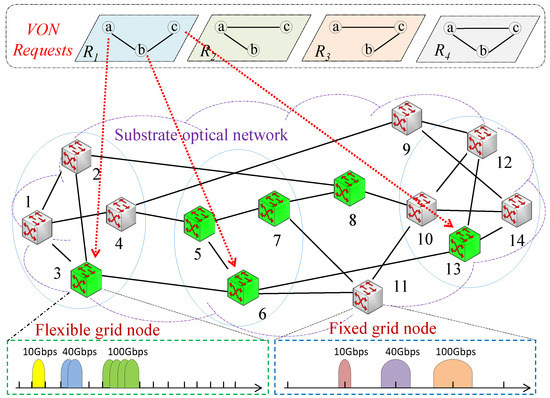
Figure 1.
VON provisioning over fixed/flexible grid optical networks.
The co-existing of fixed-grid nodes and flexible-grid nodes also leads to two kinds of spectrum, which constrains joining into the RSA problem. Spectrum assignment cases are shown in Figure 2. Here we assume that the fixed-grid node spectral bandwidth is 50 GHz and the flexible-grid node spectral bandwidth is 12.5 GHz. The spectrum is shared as the common resources, and four cases will exist for VON requests due to the routing with different type of passed nodes in mixed-fixed/flex grid optical networks (Figure 2). We can see that when the source node is a fixed-grid node, the spectrum resources for each link on this path can only be allocated according to the fixed-grid granularity slice (50 GHz). The reason is the switching granularity of the fixed-grid node cannot be smaller than 50 GHz [20], and the next frequency spectrum will only be carried at a coarser granularity, regardless of whether it is a fixed-grid or flexible-grid node. If the source node is a flexible-grid node, it can occupy a spectrum frequency closer to the size of the service. However, if the path needs to pass through one or more fixed-grid node(s), the frequency still needs to be converted to 50 GHz at the fixed-grid node, as shown in Figure 2c.
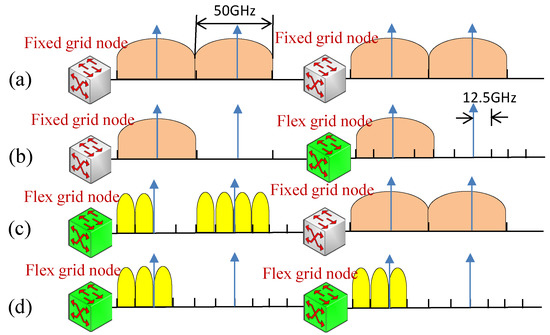
Figure 2.
Spectrum assignment cases in mixed-fixed/flexible-grid optical infrastructures: (a) origin from fixed grid node and pass fixed grid node; (b) origin from fixed grid node and pass flex grid node; (c) origin from flex grid node and pass fixed grid node; (d) origin from flex grid node and pass flex grid node.
3. Network Model and VON Provisioning Algorithm
Based on the idea described in Section 2, we model the network in Section 3.1, and then a flexible-grid aware VNE algorithm is proposed in Section 3.2. Also, we give a brief description for a flexible-grid unaware VNE algorithm, as a comparison.
3.1. Network Model
Several parameter definitions are listed in Table 1. Suppose the substrate network is modeled as an undirected weighted graph , where denotes the set of substrate nodes ( is the total number of nodes, including fixed-grid and flexible-grid), and denotes the set of substrate fiber links ( is the total number of links). The computing capacity of a substrate node is expressed as , while the bandwidth capacity of a substrate fiber link is denoted as . Similarly, the VON requests are modeled as , where is the total number of VON requests. More specifically, , where denotes the set of virtual nodes for VON request ( is the total number of virtual nodes), and denotes the set of virtual links for VON request ( is the total number of virtual links). The computing requirement of a virtual node is expressed as , while the bandwidth requirement of a virtual link is denoted as . The virtual network provisioning problem can be defined as: given the substrate network and any VON request , we need to find the mapping of VON nodes and links to the substrate nodes and links (i.e., and ) while satisfying the requirements: (1) a virtual node must be mapped to only one substrate node such that ; and (2) a virtual link must be mapped to a spectrum path including one/several substrate link(s), i.e., (), such that for each substrate link .

Table 1.
Parameter definitions.
3.2. VON Provisioning Algorithm
The VNE problem is considered as an NP-hard problem; it refers to the process of allocating physical resources to virtual nodes and virtual links [4]. Thus, the problem of VON Provisioning can be extremely hard; the optimal mapping is affected by many factors such as network topology, routing and wavelength/spectrum allocation algorithms, network traffic load, traffic distribution, etc. In such a situation, heuristics are and will stay useful for approaching the optimal mapping. In this section, we propose a heuristic algorithm called Flexible-grid Aware-Virtual Network Embedding Algorithm (FA-VNE). The detailed procedures are shown in Algorithm 1. The process of VON Provisioning mainly consists of two parts, virtual node mapping and virtual link mapping. First, we need to initialize the result set and sort the nodes in and for fixed/flexible-grid nodes based on and in descending order, respectively. Note that the node degree as well as its computing requirement (computing capacity) are considered when ordering the virtual (substrate) nodes in (). Specifically, the value of and are computed as and respectively, where and are the nodal degree of and . Here, the geographic constraints are not considered to simplify the problem.
As for the virtual node mapping, flexible nodes have finer granularity, which leads to more flexible spectrum allocation and less spectrum waste. Thus, the virtual nodes are set to be prone mapped onto flexible-grid nodes in the substrate network in order to make the best use of the flexible-grid technology, which is called Flexible-grid Aware. Traversing each in and in following a virtual node mapped to only one substrate node , until each in maps to the most appropriate . is preferred versus in traversal. If neither nor can be mapped to a VON request , node mapping fails and this request is blocked. When the virtual node mapping succeed, link mapping can be executed then. A spectrum path is chosen under the requirement that a virtual link must be mapped to a spectrum path including one/several substrate link(s). If the spectrum path from () to () cannot be found, block request . Note in line 24, the RSA algorithm that satisfies the fixed/flexible-grid spectrum constraint is used for finding a path in , which could be found in [25,27,28].
| Algorithm 1 Flexible-Grid Aware-Virtual Network Embedding Algorithm (FA-VNE) |
| Input: and Output: () and() |
|
The computational complexity related to this algorithm is bounded by . Lines 1 to 5 require operations. Lines 7 to 12 require at most operations. Similarly, lines 13 to 20 require at most operations. Lines 6 to 22 require at most operations. Lines 23 to 29 require operations. corresponds to the worst-case complexity of finding the mapping.
In the performance Evaluation part, the Flexible-grid Unaware-Virtual Network Embedding Algorithm (FU-VNE), which does not consider the flexible-grid nodes with higher-priority during VON provisioning, is compared as the baseline. The procedure of the FU-VNE algorithm is shown in Algorithm 2.
| Algorithm 2 Flexible-Grid Unaware-Virtual Network Embedding Algorithm (FU-VNE) |
| Input: and Output: |
|
4. Performance Evaluation
We evaluate the performance of the proposed FA-VNE algorithm in the 14-node NSFNET topology shown in Figure 3, where the computing capacity of a substrate node is set to 500 units, and the computing requirements of a virtual node are randomly chosen from [1, 3] units. The spectrum capacity in a substrate link is set to 8 THz (evenly divided in each direction), and the bandwidth requirements of a virtual link are randomly chosen among [40, 100, 200, 400] Gb/s. For these demands, [50, 50, 100, 200] GHz spectrum are assumed to be required by fixed-grid nodes/links, while [25, 37.5, 75, 125] GHz spectrum are assumed to be required by flexible-grid nodes/links (the distance-adaptive modulation format is not considered here). Following Poisson arrivals, 50,000 VON requests are generated (the serving rate is fixed to 1, so the traffic load is determined by the arriving rate). Each VON request is generated with [3,5] virtual nodes, and the virtual links between virtual nodes are randomly created by the Erdos–Renvi model, with a probability ( is set to 0.5 and 0.7 in the simulation). The KSP routing algorithm is used to map virtual links with K = 3. During simulation, all VON requests are served in a First-Come-First-Served (FCFS) manner. We consider four different Network Scenarios (NS) as shown in Table 2. In NS-A and NS-B, low-bandwidth demands (e.g., 40 Gb/s) are predominant, while in NS-C and NS-D, high-bandwidth demands (e.g., 200 Gb/s and 400 Gb/s) are predominant, compared with low-bandwidth ones. Additionally, there are 30% flex-nodes in NS-A and NS-C, and 60% flex-nodes in NS-B and NS-D.

Figure 3.
NSFNET topology used for simulation.

Table 2.
Parameters in different Network Scenarios (NS).
In the simulation, we use the FU-VNE algorithm as a baseline for comparison. Figure 4a–d shows the performance in terms of the Blocking Probability (BP) of FA-VNE and FU-VNE under different NSs. Each sub graph in Figure 4 takes blocking probability as the y-axis, which represents the blocking probability of the VON services in each NS. Taking traffic load as the x-axis, the values shown at each point are the expected values of the blocking probability of 5000 VON Poisson services under the corresponding traffic load. The first bar and the third bar of each traffic load are the proposed FA-VNE algorithm with α values of 0.5 and 0.7, while the second bar and the fourth bar are FU-VNE as a comparison algorithm, and α value is also set to be 0.5 and 0.7, respectively.
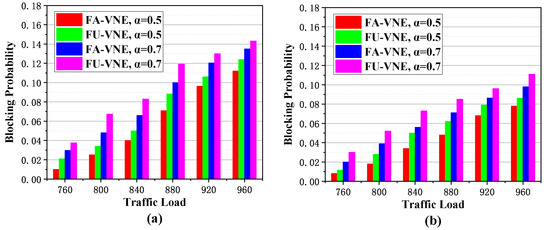
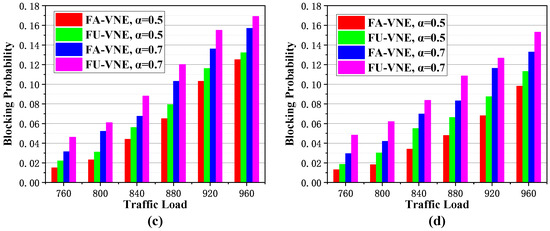
Figure 4.
Simulation and results: (a) BP under NS-A; (b) BP under NS-B; (c) BP under NS-C; and (d) BP under NS-D.
The result in Figure 4a is obtained by simulating NS-A, where low-bandwidth demands (e.g., 40 Gb/s) dominate and contain fewer flexible-grid nodes (30%). It can be seen from Figure 4a that blocking probabilities increase with the increase of traffic load for all cases. Additionally, considering a flexible-grid aware approach can reduce the blocking probabilities up to 52%, which indicates that FA-VNE greatly improves the network performance compared with FU-VNE. It is an interesting phenomenon that when the probability of virtual link generation is set to 0.5 (α is 0.5) in the FA-VNE and FU-VNE algorithms, lower blocking probability can be achieved in both cases. Thus, higher probability of virtual link generation does not mean that the network performance improves. From the other subgraphs in Figure 4, we can obtain the same information as Figure 4a. Figure 4b is obtained by simulating NS-B, where low-bandwidth demands (e.g., 40 Gb/s) dominate and contain more flexible-grid nodes (30%). By comparing Figure 4a and b, we find that when the percentage of flexible-grid node increases, FA-VNE has a more prominent advantage in blocking probability than FU-VNE. The reason is that FA-VNE is prone to select flexible-grid nodes in the process of node mapping for the incoming VON requests, and more flexible-grid based channels can be set up to save spectrum resources in the substrate optical network, which can contribute to reduce the VON blocking probability. The comparison of Figure 4c,d shows a similar trend, which were respectively obtained by simulating NS-C and NS-D. Also note that with the increase of high-bandwidth VON demands, FA-VNE shows certain advantages by comparing Figure 4a,c or Figure 4b,d. For example, when the traffic load is 880 Erlang, the blocking probability of FA-VNE is 22.6% lower than FU-VNE when α is 0.5 and 16.5% lower than FU-VNE when α is 0.7 in Figure 4b, while in Figure 4d, the percentage is 27.5% and 23.4% respectively.
The performance of FA-VNE and that of FU-VNE, in terms of Link Utilization Ratio (LUR), are also evaluated as shown in Figure 5a–d for different NSs. The link utilization ratio is defined as the ratio of average amount of bandwidth used to the total bandwidth in the link. The first and third curves of each traffic load are the link utilization ratios of the proposed FA-VNE algorithm with different α values, the second and fourth curves are the link utilization ratios of FU-VNE. The result in Figure 5a is obtained by simulating NS-A. From the figure we can see that the link utilization ratio increases with the increase in the traffic load for all cases, with FA-VNE performing 16% better than FU-VNE. The reason is FA-VNE better identifies node/link mapping with less blocking probability. Additionally, higher link utilization is also achieved when α is 0.5. Higher probability of virtual link generation failed to achieve excellent performance in terms of both blocking probability and link utilization ratio. From the other subgraphs in Figure 5, we can obtain the same information as Figure 5a. Figure 5b is obtained by simulating NS-B. The comparison between Figure 5a,b or Figure 5c,d shows when the network contains more flexible-grid nodes, the advantage is a little more obvious. For example, the highest improvement of FA-VNE is 15%, while it is 11% for FU-VNE. Also, the comparison between Figure 5a,b or Figure 5c,d manifests as high-bandwidth VON demands increase, as the advantage of FA-VNE becomes more obvious.
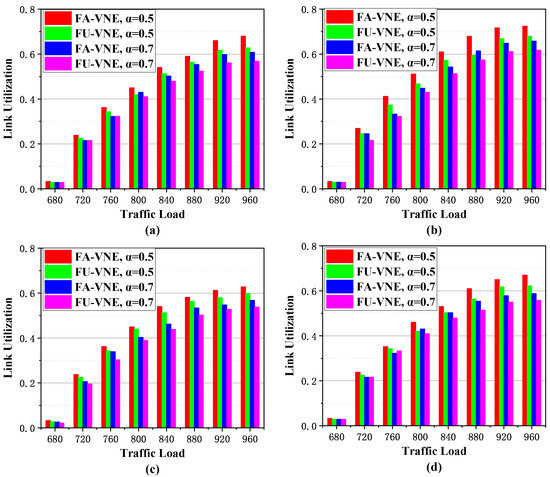
Figure 5.
Simulation and results: (a) LUR under NS-A; (b) LUR under NS-B; (c) LUR under NS-C; and (d) LUR under NS-D.
5. Conclusions
Brown-field migration from a fixed-grid to a flexible-grid network will be a long process. In order to make better use of management means to pass this period smoothly; we explore how the problem of VNE can be solved when considering mixed-fixed/flexible-grid optical infrastructure in this paper. The problem of VON provisioning over co-existing fixed/flexible grid optical networks is introduced firstly. A flexible-grid aware virtual network embedding algorithm is proposed and evaluated under four different network scenarios. Simulation results show that considering a flexible-grid aware approach can largely reduce the blocking probabilities, and a flexible-grid aware approach can lead to significant savings in spectrum resources compared to the cases when no flexible-grid network configuration is taken into consideration. Also, higher probability of virtual link generation can lead to lower blocking probability. In addition, the VNE problem over co-existing fixed/flexible grid optical networks under a static scenario is also very important, and our future work will focus on the ILP model and lower/upper bound analysis of corresponding solutions.
Author Contributions
Conceptualization, X.Y., Y.Z. and J.Z.; methodology, X.Y. and Y.Z.; software, L.L.; validation, L.L. and X.Y.; writing—original draft preparation, X.Y.; writing—review and editing, L.L., Y.Z., F.W., A.N., X.L. and J.Z.; supervision, J.Z. All authors have read and agreed to the published version of the manuscript.
Funding
This work was supported by funding of the science and technology research and development project of Yinchuan (2021BDE13001).
Data Availability Statement
The data presented in this study are available on request from the corresponding author. The data are not publicly available due to privacy.
Conflicts of Interest
The authors declare no conflict of interest.
References
- Zhang, Q.; Xie, W.; She, Q.; Wang, X.; Palacharla, P.; Sekiya, M. RWA f or network virtualization in optical WDM networks. In Proceedings of the 2013 Optical Fiber Communication Conference and Exposition and the National Fiber Optic Engineers Conference (OFC/NFOEC), Anaheim, CA, USA, 17–21 March 2013. [Google Scholar]
- Shakya, S.; Pradhan, N.; Cao, X.; Ye, Z.; Qiao, C. Virtual network embedding and reconfiguration in elastic optical networks. In Proceedings of the 2014 IEEE Global Communications Conference, Austin, TX, USA, 8–12 December 2014. [Google Scholar]
- Chaudhari, S.; Mani, R.S.; Raundale, P. SDN network virtualization survey. In Proceedings of the 2016 International Conference on Wireless Communications, Signal Processing and Networking (WiSPNET), Chennai, India, 23–25 March 2016. [Google Scholar]
- Belbekkouche, A.; Hasan, M.; Karmouch, A. Resource discovery and allocation in network virtualization. IEEE Commun. Surv. Tutor. 2012, 14, 1114–1128. [Google Scholar] [CrossRef]
- Chowdhury, N.M.K.; Boutaba, R. A survey of network virtualization. Comput. Netw. 2010, 54, 862–876. [Google Scholar] [CrossRef]
- Hwang, J.; Ramakrishnan, K.; Wood, T. NetVM: High performance and flexible networking using virtualization on commodity platforms. IEEE Trans. Netw. Serv. Manag. 2015, 12, 34–47. [Google Scholar] [CrossRef]
- Khan, A.; Zugenmaier, A.; Jurca, D.; Kellerer, W. Network virtualization: A hypervisor for the Internet? IEEE Commun. Mag. 2012, 50, 136–143. [Google Scholar] [CrossRef]
- Blenk, A.; Basta, A.; Reisslein, M.; Kellerer, W. Survey on Network Virtualization Hypervisors for Software Defined Networking. IEEE Commun. Surv. Tutor. 2016, 18, 655–685. [Google Scholar] [CrossRef] [Green Version]
- Barakabitze, A.A.; Ahmad, A.; Mijumbi, R.; Hines, A. 5G network slicing using SDN and NFV: A survey of taxonomy, architectures and future challenges. Comput. Netw. 2020, 167, 106984. [Google Scholar] [CrossRef]
- Koponen, T.; Amidon, K.; Balland, P.; Casado, M.; Chanda, A.; Fulton, B.; Ganichev, I.; Gross, J.; Ingram, P.; Jackson, E.; et al. Network virtualization in multi-tenant datacenters. In Proceedings of the 11th USENIX Symposium on Networked Systems Design and Implementation (NSDI 14), Seattle, WA, USA, 2–4 April 2014. [Google Scholar]
- Fischer, A.; Botero, J.F.; Beck, M.T.; De Meer, H.; Hesselbach, X. Hesselbach. Virtual network embedding: A survey. IEEE Commun. Surv. Tutor. 2013, 15, 1888–1906. [Google Scholar] [CrossRef]
- Dávalos, E.J.; Barán, B. A Survey on Algorithmic Aspects of Virtual Optical Network Embedding for Cloud Networks. IEEE Access 2018, 6, 20893–20906. [Google Scholar] [CrossRef]
- Gerstel, O.; Jinno, M.; Lord, A.; Yoo, S.J.B. Elastic optical networking: A new dawn for the optical layer? IEEE Commun. Mag. 2012, 50, s12–s20. [Google Scholar] [CrossRef]
- Peng, S.; Nejabati, R.; Simeonidou, D. Impairment-Aware Optical Network Virtualization in Single-Line-Rate and Mixed-Line-Rate WDM Networks. J. Opt. Commun. Netw. 2013, 5, 283–293. [Google Scholar] [CrossRef]
- Shahriar, N.; Taeb, S.; Chowdhury, S.R.; Tornatore, M.; Boutaba, R.; Mitra, J.; Hemmati, M. Achieving a Fully-Flexible Virtual Network Embedding in Elastic Optical Networks. In Proceedings of the IEEE INFOCOM—IEEE Conference on Computer Communications, Paris, France, 29 April–2 May 2019. [Google Scholar]
- Jinno, M.; Takara, H.; Kozicki, B.; Tsukishima, Y.; Sone, Y.; Matsuoka, S. Spectrum-efficient and scalable elastic optical path network: Architecture, benefits, and enabling technologies. IEEE Commun. Mag. 2009, 47, 66–73. [Google Scholar] [CrossRef]
- Zhu, M.; Sun, Q.; Zhang, S.; Gao, P.; Chen, B.; Gu, J. Energy-Aware Virtual Optical Network Embedding in Sliceable-Transponder-Enabled Elastic Optical Networks. IEEE Access 2019, 7, 41897–41912. [Google Scholar] [CrossRef]
- Ding, S.; Bose, S.; Shen, G. Spectrum trading between virtual optical networks with time-varying traffic in an elastic optical network. J. Opt. Commun. Netw. 2020, 12, 24–37. [Google Scholar] [CrossRef]
- Ding, S.; Shen, G.; Pan, K.X.; Bose, S.K.; Zhang, Q.; Mukherjee, B. Blockchain-Assisted Spectrum Trading Between Elastic Virtual Optical Networks. IEEE Netw. 2020, 34, 205–211. [Google Scholar] [CrossRef]
- Patel, A.; Ji, P.; Huang, Y.; Wang, T. Distance-Adaptive Virtual Network Embedding in Software-Defined Optical Networks. In Proceedings of the OptoElectronics and Communications Conference Held Jointly with 2013 International Conference on Photonics in Switching, Kyoto, Japan, 30 June–4 July 2013. [Google Scholar]
- Lin, R.; Luo, S.; Zhou, J.; Wang, S.; Cai, A.; Zhong, W.; Zukerman, M. Virtual Network Embedding with Adaptive Modulation in Flexi-Grid Networks. J. Lightwave Technol. 2018, 36, 3551–3563. [Google Scholar] [CrossRef]
- Zhu, M.; Zhang, S.; Sun, Q.; Li, G.; Chen, B.; Gu, J. Fragmentation-Aware VONE in Elastic Optical Networks. J. Opt. Commun. Netw. 2018, 10, 809–822. [Google Scholar] [CrossRef]
- Lin, R.; Luo, S.; Wang, H.; Wang, S. Energy-aware virtual network embedding in flexi-grid networks. Opt. Express 2017, 25, 29699–29713. [Google Scholar] [CrossRef]
- Lin, R.; Luo, S.; Zhou, J.; Wang, S.; Chen, B.; Zhang, X.; Cai, A.; Zhong, W.; Zukerman, M. Column generation algorithms for virtual network embedding in flexi-grid optical networks. Opt. Express 2018, 26, 10898–10913. [Google Scholar] [CrossRef] [PubMed]
- Yu, X.; Tornatore, M.; Xia, M.; Wang, J.; Zhang, J.; Zhao, Y.; Zhang, J.; Mukherjee, B. Migration from fixed grid to flexible grid in optical networks. IEEE Commun. Mag. 2015, 53, 2. [Google Scholar] [CrossRef]
- Mayoral, A.; López, V.; de Dios, O.G.; Fernández-Palacios, J. Migration Steps Toward Flexi-Grid Networks. J. Opt. Commun. Netw. 2014, 6, 988–996. [Google Scholar] [CrossRef]
- Yu, X.; Zhao, Y.; Zhang, J.; Mukherjee, B.; Zhang, J.; Wang, X. Static Routing and Spectrum Assignment in Co-existing Fixed/Flex Grid Optical Networks. In Proceedings of the Optical Fiber Communication Conference, OSA Technical Digest (online), San Francisco, CA, USA, 9–13 March 2014. [Google Scholar]
- Yu, X.; Tornatore, M.; Zhao, Y.; Zhang, J.; Wang, X.; Zhang, S.; Wang, R.; Wang, J.; Zhang, J.; Mukherjee, B. When and how should the optical network be upgraded to flex grid? In Proceedings of the European Conference on Optical Communication (ECOC), Cannes, France, 21–25 September 2014. [Google Scholar]
- Rofoee, B.; Zervas, G.; Yan, Y.; Amaya, N.; Simeonidou, D. Flexible and Adaptive Optical Metro Networking on Fixed/Flex Grid Exploiting Hybrid Time/Frequency for Shared Resource Allocation. In Proceedings of the European Conference and Exhibition on Optical Communication, OSA Technical Digest (Online), Amsterdam, The Netherlands, 16–20 September 2012. [Google Scholar]
- Ahmed, T.; Rahman, S.; Ferdousi, S.; Tornatore, M.; Mitra, A.; Chatterjee, B.C.; Mukherjee, B. Dynamic routing, spectrum, and modulation-format allocation in mixed-grid optical networks. J. Opt. Commun. Netw. 2020, 12, 79–88. [Google Scholar] [CrossRef] [Green Version]
- Palkopoulou, E.; Angelou, M.; Klonidis, D.; Christodoulopoulos, K.; Klekamp, A.; Buchali, F.; Varvarigos, E.; Tomkos, I. Quantifying Spectrum, Cost, and Energy Efficiency in Fixed-Grid and Flex-Grid Networks [Invited]. J. Opt. Commun. Netw. 2012, 4, B42–B51. [Google Scholar] [CrossRef]
- Papanikolaou, P.; Soumplis, P.; Manousakis, K.; Papadimitriou, G.; Ellinas, G.; Christodoulopoulos, K.; Varvarigos, E. Minimizing Energy and Cost in Fixed-Grid and Flex-Grid Networks. J. Opt. Commun. Netw. 2015, 7, 337–351. [Google Scholar] [CrossRef]
- Zong, Y.; Ou, Y.; Hammad, A.; Kondepu, K.; Nejabati, R.; Simeonidou, D.; Liu, Y.; Guo, L. Location-Aware Energy Efficient Virtual Network Embedding in Software-Defined Optical Data Center Networks. J. Opt. Commun. Netw. 2018, 10, B58–B70. [Google Scholar] [CrossRef]
- Zhu, Q.; Yu, X.; Zhao, Y.; Nag, A.; Zhang, J. Auxiliary-Graph-Based Energy-Efficient Traffic Grooming in IP-Over-Fixed/Flex-Grid Optical Networks. J. Lightwave Technol. 2021, 39, 3011–3024. [Google Scholar] [CrossRef]
- Yu, X.; Lu, L.; Zhao, Y.; Zhang, J. VON Provisioning Over Co-Existing Fixed/Flexible Grid Optical Networks. In Proceedings of the Opto-Electronics and Communications Conference (OECC), Hongkong, China, 3–7 July 2021. [Google Scholar]
Publisher’s Note: MDPI stays neutral with regard to jurisdictional claims in published maps and institutional affiliations. |
© 2021 by the authors. Licensee MDPI, Basel, Switzerland. This article is an open access article distributed under the terms and conditions of the Creative Commons Attribution (CC BY) license (https://creativecommons.org/licenses/by/4.0/).